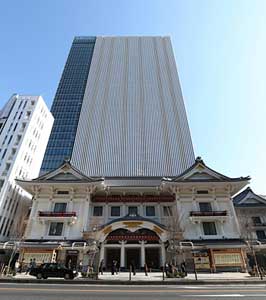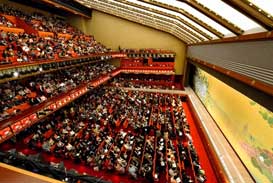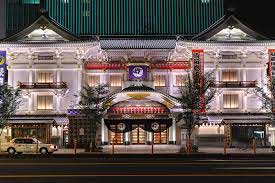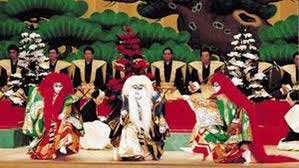
Travel Guide
Introduction
Kabuki-za is Japan’s most famous and grandest Kabuki theatre for the traditional kabuki drama form. It started to function in Tokyo in 1889, but was immediately recognized as the center of Japanese theater culture.
Kabuki-za to be destroyed by fire in 1921. While the replacement building was still under construction, it was damaged by the 1923 Kanto earthquake, but was completed in 1924. This was later was destroyed in World War Two. In 1951 a replacement theater was opened in which to continue the city's finest traditional Kabuki. Kabuki-za was again reconstructed recently and reopened in April 2013. It closely resembles its predecessor except for a skyscraper that now stands above it.
 The new Kabuki-za boasts a variety of facilities and attractions for a wide range of people to enjoy. Kobikicho Plaza is directly connected to Higashi-ginza station on the subway line, and is full of lively shops and eateries. In the theatre lobby, you will find stalls selling lunchboxes and a range of goods. The festival-like atmosphere these stalls create will turn your initial nerves into feelings of excitement. In the theatre, the pillars on the first floor have been removed, and the main seats have been made a size larger, enabling you to sit in comfort. To alleviate the concerns of those less-experienced with Kabuki and who worry that the story may be difficult to follow, a new subtitle guide system has been introduced, in addition to the audio guides. Even if it is your first time to watch Kabuki, you will definitely enjoy it at the new Kabuki-za! Why not take a step into the world of Kabuki?
The new Kabuki-za boasts a variety of facilities and attractions for a wide range of people to enjoy. Kobikicho Plaza is directly connected to Higashi-ginza station on the subway line, and is full of lively shops and eateries. In the theatre lobby, you will find stalls selling lunchboxes and a range of goods. The festival-like atmosphere these stalls create will turn your initial nerves into feelings of excitement. In the theatre, the pillars on the first floor have been removed, and the main seats have been made a size larger, enabling you to sit in comfort. To alleviate the concerns of those less-experienced with Kabuki and who worry that the story may be difficult to follow, a new subtitle guide system has been introduced, in addition to the audio guides. Even if it is your first time to watch Kabuki, you will definitely enjoy it at the new Kabuki-za! Why not take a step into the world of Kabuki?
Kabukiza Gallery
The 5th floor of Kabukiza Tower has a roof garden and a gallery. There is an admission fee for the gallery, however you can enter the building freely. You can enjoy Kabuki in a short time on days and at times when there are no performances. Costumes and stage props used in actual performances are on display, and lectures and performance demonstrations are scheduled to be held. There is also a photo studio where you can dress up in Kabuki costumes and have your photograph taken. It is a place you should not miss!
Performance time
Kabuki shows typically last about 4 to 5 hours. Matinees start at about 11am, and evening shows at around 4pm. If that all sounds too much for you, tickets to watch a single act from the 4th floor gallery go on sale on the day of the performance, but turn up early as they often sell out fast.
Performances
Performances are exclusively run by Shochiku. They are nearly every day, and tickets are sold for individual acts as well as for each play in its entirety. As is the case for most kabuki venues, programs are organized monthly: each month there is given set of plays and dances that make up the afternoon performance, and a different set comprising the evening show. These are repeated on a nearly daily schedule for three to four weeks, with the new month bringing a new program.
History
The Kabuki-za was originally opened by a Meiji era journalist, Fukuchi Gen'ichiro. Fukuchi wrote kabuki dramas in which Ichikawa Danjuro IX and others starred; upon Danjuro's death in 1903, Fukuchi retired from the management of the theatre. The theatre was then taken over by the Shochiku Corporation in 1914; the theatre is exclusively run by the company since.


Travel Advice
|
|||
Visit
| Address | 4-12-15 Ginza, Chuo-ku, Tokyo | |
| Phone | 03-3545-6800 | |
| Admission | May vary depending on the track | |
| Hours | May vary depending on the track | |
| Closed | Irregular | |
| Duration | May vary depending on the track | |
| Getting There | By Train 1 minute walk from Higashi-ginza Station on subway Hibiya Line or subway Asakusa Line. By Car Take Tokyo Expressway to the Shin-kyobashi exit. It is approximately 1 kilometer, 1 minute from exit. |
|
| Parking | Paid parking available | |


 What is it?
What is it?